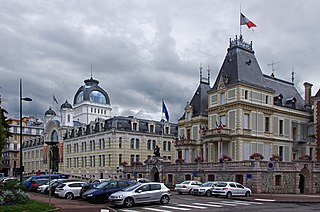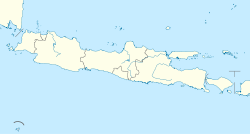
A village is a clustered human settlement or community, larger than a hamlet but smaller than a town, with a population typically ranging from a few hundred to a few thousand. Though villages are often located in rural areas, the term urban village is also applied to certain urban neighborhoods. Villages are normally permanent, with fixed dwellings; however, transient villages can occur. Further, the dwellings of a village are fairly close to one another, not scattered broadly over the landscape, as a dispersed settlement.

Japan is divided into 47 prefectures, which rank immediately below the national government and form the country's first level of jurisdiction and administrative division. They include 43 prefectures proper, two urban prefectures, one "circuit" or "territory" and one metropolis. In 1868, the Meiji Fuhanken sanchisei administration created the first prefectures to replace the urban and rural administrators in the parts of the country previously controlled directly by the shogunate and a few territories of rebels/shogunate loyalists who had not submitted to the new government such as Aizu/Wakamatsu. In 1871, all remaining feudal domains (han) were also transformed into prefectures, so that prefectures subdivided the whole country. In several waves of territorial consolidation, today's 47 prefectures were formed by the turn of the century. In many instances, these are contiguous with the ancient ritsuryō provinces of Japan.

A district is a type of administrative division that, in some countries, is managed by the local government. Across the world, areas known as "districts" vary greatly in size, spanning regions or counties, several municipalities, subdivisions of municipalities, school district, or political district.

Tambon is a local governmental unit in Thailand. Below district (amphoe) and province (changwat), they form the third administrative subdivision level. As of 2016 there were 7,255 tambons, not including the 180 khwaeng of Bangkok, which are set at the same administrative level, thus every district contains eight to ten tambon. Tambon is usually translated as "township" or "subdistrict" in English — the latter is the recommended translation, though also often used for king amphoe, the designation for a subdistrict acting as a branch of the parent district. Tambon are further subdivided into 69,307 villages (muban), about ten per tambon. Tambon within cities or towns are not subdivided into villages, but may have less formal communities called chumchon that may be formed into community associations.

According to the Moldovan law on territorial administrative organisation, Moldova is divided administratively into the following administrative territorial units: districts, cities/towns and villages. The administrative territorial organization of Moldova is made on 2 levels:
- villages (communes), sectors and cities/towns (municipii) constitute the first level,

The administrative divisions of Ukraine are subnational administrative divisions within the geographical area of Ukraine under the jurisdiction of the Ukrainian Constitution. Ukraine is a unitary state with four tiers of subnational government: (1) oblasts or regions (mostly), (2) raions or districts, (3) city councils and (4) rural councils.

An administrative center is a seat of regional administration or local government, or a county town, or the place where the central administration of a commune is located.
A kaza is an administrative division historically used in the Ottoman Empire and is currently used in several of its successor states. The term is from Ottoman Turkish and means 'jurisdiction'; it is often translated 'district', 'sub-district', or 'juridical district'.
The administrative divisions of India are subnational administrative units of India; they are composed of a nested hierarchy of administrative divisions.

Since the Declaration of Independence in 1912, Albania has undergone administrative territorial reforms a total of 21 times. Its administrative boundaries have been divided and/or merged into regions (krahina), prefectures, sub-prefectures, counties (qarqe), districts (rrethe), municipalities (bashki), cities, communes (komuna), neighborhoods (lagje), villages and localities. The country is presently divided into 12 counties, 61 municipalities and 373 administrative units.
A nāḥiyah, or nahia, is a regional or local type of administrative division that usually consists of a number of villages or sometimes smaller towns. In Tajikistan, it is a second-level division while in Syria, Iraq, Lebanon, Jordan, Xinjiang, and the former Ottoman Empire, where it was also called a bucak, it is a third-level or lower division. It can constitute a division of a qadaa, mintaqah or other such district-type of division and is sometimes translated as "subdistrict".

In geography, statistics and archaeology, a settlement, locality or populated place is a community in which people live. The complexity of a settlement can range from a minuscule number of dwellings grouped together to the largest of cities with surrounding urbanized areas. Settlements may include hamlets, villages, towns and cities. A settlement may have known historical properties such as the date or era in which it was first settled, or first settled by particular people.

The 28 provinces of Bulgaria are divided into 265 municipalities. Municipalities typically comprise multiple towns, villages and settlements and are governed by a mayor who is elected by popular majority vote for a four-year term, and a municipal council which is elected using proportional representation for a four-year term. The creation of new municipalities requires that they must be created in a territory with a population of at least 6,000 and created around a designated settlement. They must also be named after the settlement that serves as the territory's administrative center, among other criteria.

Municipalities are the basic administrative divisions of Albania. Prior to 2015, there were two types of municipalities in Albania: municipalities with an urban character called bashki, and municipalities with a rural character called komunë (commune). Municipalities are all divided into at least two "administrative units", which are sometimes referred to as "municipal units" or "units of local governance". Administrative units are composed of one or more cities, villages, or neighbourhoods and constitute the third- and final-level administrative divisions of Albania.

The administrative divisions of Tanzania are controlled by Part I, Article 2.2 of the Constitution of Tanzania. Tanzania is divided into thirty-one regions. Each region is subdivided into districts. The districts are sub-divided into divisions and further into local wards. Wards are further subdivided for management purposes: for urban wards into streets and for rural wards into villages. The villages may be further subdivided into hamlets.
A tehsil is a local unit of administrative division in some countries of the Indian subcontinent that is usually translated to "township". It is a subdistrict of the area within a district including the designated city, town, hamlet, or other populated place that serves as its administrative centre, with possible additional towns, and usually a number of villages. The terms in India have replaced earlier geographical terms, such as pargana (pergunnah) and thana.

Populated place in Ukraine is a structural element of human settling system, a stationary settlement, territorially integral compact area of population concentration basic and important feature of which is permanent human habitation. Populated places in Ukraine are systematized into two major categories: urban and rural. Urban populated places can be either cities or urban settlements, while rural populated places can be either villages or rural settlements. According to the 2001 Ukrainian Census there are 1,344 urban populated places and 28,621 rural populated places in Ukraine.
According to the Moldovan law on territorial administrative organisation, two or more villages can form together a commune.













